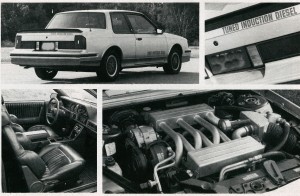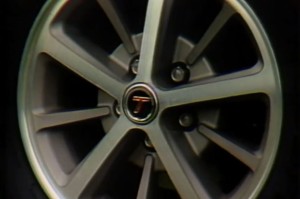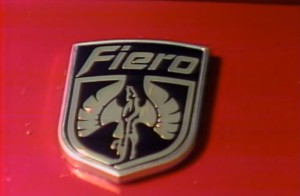1984 General Motors Model Lineup Updates
At General Motors, 1984 was to be a year of polishing and perfecting. With the exception of the new A-wagons, Corvette and Pontiac Fiero, there was no new sheet metal to speak of and very few technological innovations. There were however, some significant refinements of existing products.
Perhaps the most startling of all wasn’t experimental Oldsmobile diesel that felt nothing like diesels were supposed  to feel. The 4.3 liter oil burner was a virtual rocket compared to the current in the GM system, even though the 4.3 V6 it’s based on was one of the favorites. The miracle of forward motion was accomplished without the benefit of turbocharging. Instead, Oldsmobile engineers designed a ram tuned induction system for the engine. Oldsmobile was quick to emphasize that this project was strictly and Engineering exercise and definitely not bound for production. But if ever there was a way of activating all that idle diesel capacity, this Ram tuned system was it.
to feel. The 4.3 liter oil burner was a virtual rocket compared to the current in the GM system, even though the 4.3 V6 it’s based on was one of the favorites. The miracle of forward motion was accomplished without the benefit of turbocharging. Instead, Oldsmobile engineers designed a ram tuned induction system for the engine. Oldsmobile was quick to emphasize that this project was strictly and Engineering exercise and definitely not bound for production. But if ever there was a way of activating all that idle diesel capacity, this Ram tuned system was it.
Another eye-opener was the Chevrolet Cavalier for 1984. Gone was the jiggly suspension, lack of on center steering feel, and the crunchy clutch engagement. Best of all, the 5 speed gearbox actually shifted without argument. At long last, the J-car could lay claim to the title of import fighter. Not all the divisions J-cars were quite as good on this score. Chevy had exclusive ownership of the new steering rack that’s responsible for most of the improvements in feel and precision, though most of the other changes made it to the other divisions J Cars. The born-again suspension was the results of different bushing material, and reworking the innards of the gearbox accomplished the slick shifting performance.
 On the electronics front, Buick continued to be on the cutting edge of technology, after years of speculation, the distributorless ignition system was finally here, brought to you courtesy of Buick division. The system did away with a cap and rotor, the weakest links in an otherwise strong chain. On its multiport fuel injection system, Buick also came up with a hot film mass air flow sensor, a definite improvement over the hot wire air flow sensor, which was more prone to failure and calibration errors.
On the electronics front, Buick continued to be on the cutting edge of technology, after years of speculation, the distributorless ignition system was finally here, brought to you courtesy of Buick division. The system did away with a cap and rotor, the weakest links in an otherwise strong chain. On its multiport fuel injection system, Buick also came up with a hot film mass air flow sensor, a definite improvement over the hot wire air flow sensor, which was more prone to failure and calibration errors.
Pontiac’s big news for 1984, of course was the Fiero, which appeared to be bound for well-deserved  stardom. Perhaps equally important was the fact that STE production increased for 1984. In 1983 the division underestimated demand, and the result was unhappy dealers who had customers waiting in line with cash in hand and no cars to buy.
stardom. Perhaps equally important was the fact that STE production increased for 1984. In 1983 the division underestimated demand, and the result was unhappy dealers who had customers waiting in line with cash in hand and no cars to buy.
Cadillac seemed to be overshadowed as a technological gap between it and the other division group. But that apparently didn’t bother Cadillac at all, since sales steadily increased.
1986 General Motors Model Lineup Updates
1983 General Motors Model Lineup Updates
Tags: 1984, 2M4, Buick, Chevrolet, Chevrolet Corvette C4, Chevy, consumer reports, General Motors, GM A-Body, GM C-body, GM F-body, GM J-body, GMC, Iron Duke, jd power, Motorweek, Oldsmobile, Pontiac, Pontiac Fiero, Review, road test, Roadtest, test drive, Testdrive

 to feel. The 4.3 liter oil burner was a virtual rocket compared to the current in the GM system, even though the 4.3 V6 it’s based on was one of the favorites. The miracle of forward motion was accomplished without the benefit of turbocharging. Instead, Oldsmobile engineers designed a ram tuned induction system for the engine. Oldsmobile was quick to emphasize that this project was strictly and Engineering exercise and definitely not bound for production. But if ever there was a way of activating all that idle diesel capacity, this Ram tuned system was it.
to feel. The 4.3 liter oil burner was a virtual rocket compared to the current in the GM system, even though the 4.3 V6 it’s based on was one of the favorites. The miracle of forward motion was accomplished without the benefit of turbocharging. Instead, Oldsmobile engineers designed a ram tuned induction system for the engine. Oldsmobile was quick to emphasize that this project was strictly and Engineering exercise and definitely not bound for production. But if ever there was a way of activating all that idle diesel capacity, this Ram tuned system was it. On the electronics front, Buick continued to be on the cutting edge of technology, after years of speculation, the distributorless ignition system was finally here, brought to you courtesy of Buick division. The system did away with a cap and rotor, the weakest links in an otherwise strong chain. On its multiport fuel injection system, Buick also came up with a hot film mass air flow sensor, a definite improvement over the hot wire air flow sensor, which was more prone to failure and calibration errors.
On the electronics front, Buick continued to be on the cutting edge of technology, after years of speculation, the distributorless ignition system was finally here, brought to you courtesy of Buick division. The system did away with a cap and rotor, the weakest links in an otherwise strong chain. On its multiport fuel injection system, Buick also came up with a hot film mass air flow sensor, a definite improvement over the hot wire air flow sensor, which was more prone to failure and calibration errors. stardom. Perhaps equally important was the fact that STE production increased for 1984. In 1983 the division underestimated demand, and the result was unhappy dealers who had customers waiting in line with cash in hand and no cars to buy.
stardom. Perhaps equally important was the fact that STE production increased for 1984. In 1983 the division underestimated demand, and the result was unhappy dealers who had customers waiting in line with cash in hand and no cars to buy.